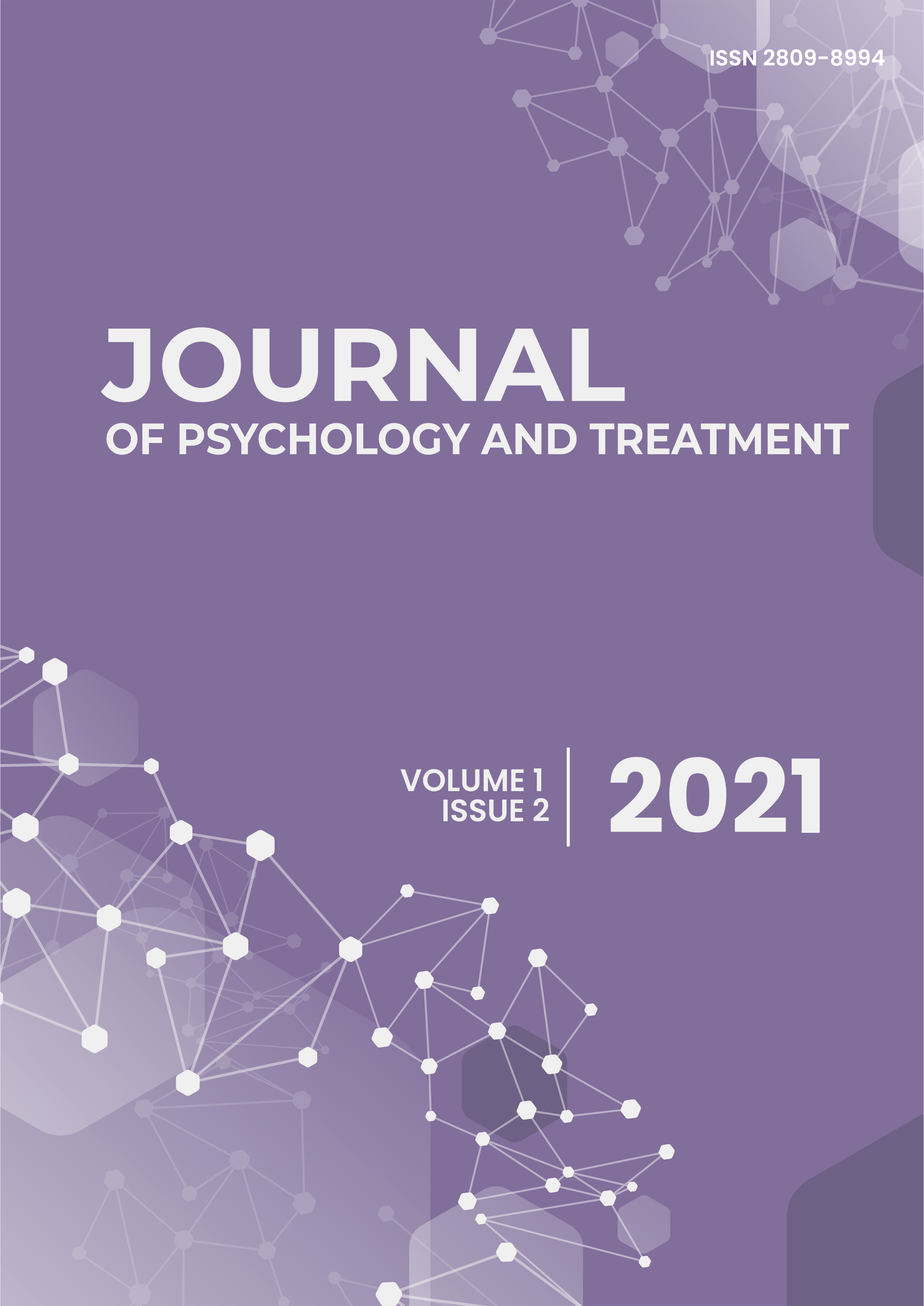Konsep Diri dengan Kecemasan Menjelang Masa Bebas pada Narapidana di Rumah Tahanan (Rutan) Kelas IIB Wonogiri, Jawa Tengah
DOI:
https://doi.org/10.53088/jpt.v1i2.2146Keywords:
anxiety, self-concept, prisonersAbstract
The purpose of this study was to examine the relationship between self-concept and prisoner anxiety before being released. The sample in this study was 30 prisoners before being released at the Class II B prison in Wonogiri, Central Java using purposive sampling technique. Data were collected using a scale. Data analysis was performed using Product Moment correlation analysis. The results of this study indicate the analysis of the relationship between self-concept variables and anxiety, the correlation coefficient value is -0.758 and the significance value is 0.000 (p < 0.01). The anxiety variable is in the low category, while the self-concept variable is in the high category. The effective contribution of the self-concept variable to anxiety is 46.2%, while the remaining 53.8% is influenced by other variables. The conclusion in this study is that there is a very significant negative relationship between self-concept and prisoners' anxiety before being released.
References
Al-Jauhar, B. M., & Imron, A. (2014). Konstruksi Masyarakat Terhadap Mantan Narapidana. Jurnal Paradigma, 2(1), 1–6.
Alizamar, Afdal, & Fikri, M. (2018). The Exploration of Young Prisoners Social Anxiety. International Conferences on Education, Social Sciences andTechnology, 121–125. Padang: Universitas Negeri Padang. https://doi.org/10.29210/2018118
Anas, M. (2013). Psycologi: Menuju Aplikasi Pendidikan. Jakarta: Pustaka Education.
Anissa, C. G. (2019). Rasa Bersalah Pada Mantan Narapidana. Semarang: Universitas Semarang.
Arnaiz-Castro, P., & Díaz, J. P. L. (2016). A Study on the Correlation Between Anxiety and Academic Self-Concept in Interpreter Trainees. Circulo de Linguistica Aplicada a la Comunicacion, 67, 57–88. https://doi.org/10.5209/CLAC.53477
Asridayanti, & Kristianingsih, S. A. (2020). Konsep Diri Dengan Kecemasan Pada Narapidana Pengguna Narkotika Dalam Menghadapi Masa Depan. Jurnal Psikologi Talenta, 5(1), 1–11. https://doi.org/10.26858/talenta.v5i1.9533
Az-Zahrani, M. bin S. (2005). Konseling Terapi. Jakarta: Gema Insani.
Calhoun, J. F., & Acocella, J. R. (1990). Psychology of Adjustment and Human Relationships. New York: McGraw-Hill.
Fakhrah, F., & Purnamaningsih, E. H. (2020). Program Aktif (Aku Positif) untuk Meningkatkan Harga Diri Menjelang Masa Bebas pada Anak Didik di Lembaga Pembinaan Khusus Anak (LPKA). Gadjah Mada Journal of Professional Psychology (GamaJPP), 6(1), 107–116. https://doi.org/10.22146/gamajpp.55364
Hanun, I. B. (2013). Studi tentang Penyesuaian Diri Mantan Narapidana di Kecamatan Banjarnegara Kabupaten Banjarnegara. Yogyakarta: Universitas Negeri Yogyakarta.
Heidari, M., Ghodusi, M., & Rafiei, H. (2017). Sexual Self-concept and Its Relationship to Depression, Stress and Anxiety in Postmenopausal Women. Journal of Menopausal Medicine, 23(1), 42–48. https://doi.org/10.6118/jmm.2017.23.1.42
Kheirkhah, M., Mokarie, H., Samani, L. N., & Hosseini, A. (2013). Relationship Between Anxiety and Self-Concept in Female Adolescents. Iran Journal of Nursing (IJN), 26(83), 19–29.
Kunarni, S. (2014). Pengaruh Meditasi Dzikir untuk Menurunkan Kecemasan pada Narapidana Wanita Menjelang Masa Bebas (Semarang: Universitas Islam Negeri Walisongo). Semarang: Universitas Islam Negeri Walisongo. Diambil dari https://eprints.walisongo.ac.id/id/eprint/3969/
Kusumawardani, D. A., & Astuti, T. P. (2014). Perbedaan Kecemasan Menjelang Bebas pada Narapidana Ditinjau dari Jenis Kelamin, Tindak Pidana, Lama Pidana, dan Sisa Masa Pidana. Empati, 3(3), 52–60.
Lubis, S. M., & Maslihah, S. (2012). Analisis Sumber-Sumber Kebermaknaan Hidup Narapidana yang Menjalani Hukuman Seumur Hidup. Jurnal Psikologi Undip, 11(1), 28–39. https://doi.org/https://doi.org/10.14710/jpu.11.1.12
Malik, M., Fatima, G., & Ch, A. H. (2016). Test Anxiety and Self-Concept of University Students Enrolled in B Ed Honors Degree Program Funded by USAID. Bulletin of Education & Research, 38(2), 83–94.
Mandira, T. M., Marjohan, M., & Fernandes, F. (2019). Gambaran kecemasan narapidana wanita di Sumatera Barat. Holistik Jurnal Kesehatan. https://doi.org/10.33024/hjk.v13i3.1665
Muyassaroh, & Handoyo, P. (2014). Dampak Labelling Pada Mantan Napi: Pengangguran Atau Pencuri. Paradigma, 2(3), 1–6.
Nolen-Hoeksema, S. (2007). Abnormal Psychology (4 ed.). Boston: Mc Graw Hill.
Nugroho, H. Y. A. (2015). Hubungan Konsep Diri dan Kecemasan Menjelang Bebas di Lembaga Pemasyarakatan Kelas II A Wirogunan Yogyakarta. Yogyakarta: Universitas Sanata Dharma.
Nurfadilah, Munadiah, W., & Irfan. (2020). Hubungan Konsep Diri dengan Kecemasan Narapidana pada Rutan Kelas II B Majene Tahun 2019. Jurnal Kesehatan Masyarakat, 6(1), 38–51.
Pratiwi, I., Albab, U., Awawin, M., Yusuf, N. M., & Ramadhani, S. S. (2014). Suara Perjuangan Narapidana Inovatif (Supernova): Model Pembinaan Narapidana Dibawah Umur dan Asisten Sipir di Lembaga Pemasyarakatan Kelas IIa Kota Bogor dengan Metode “Fun, Fight, Share.” Bogor.
Ramadhini, P. S., & Santoso, M. B. (2019). Assertveness Training untuk Meningkatkan Kepercayaan Diri Narapidana Remaja. Prosiding Penelitian dan Pengabdian kepada Masyarakat, 6(2), 123–180. https://doi.org/10.24198/jppm.v6i2.21905
Ramaiah, S. (2003). Kecemasan Bagaimana Mengatasi Penyebabnya. Jakarta: Pustaka Populer Obor.
Salim, S. U., Komariah, M., & Fitria, N. (2016). Gambaran Faktor Yang Mempengaruhi Kecemasan WBP Menjelang Bebas Di LP Wanita Kelas II A Bandung. Jurnal Ilmu Keperawatan, 4(1), 32–42.
Sugiyono. (2016). Metode Penelitian Kuantitatif, Kualitatif dan R&D. Bandung: Alfabeta.
Sutra, B. M. (2020). Peran Kunjungan Keluarga Terhadap Kondisi Psikologis Narapidana di Lapas Kelas IIB Pangkalan BUN. Syntax Literate ; Jurnal Ilmiah Indonesia, 5(8), 481–496. https://doi.org/10.36418/syntax-literate.v5i8.942
Wiradinata, R. (2015). Pelaksanaan Pembebasan Bersyarat Terhadap Narapidana Pada Lembaga Pemasyarakatan Klas IIa Pontianak. Gloria Yuris: Jurnal Hukum, 4(1), 1–3.
Yuningsih, A., Hidayat, M. A., & Hertini, R. (2019). Pengalaman Psikologis Warga Binaan Selama Menjalani Masa Hukuman di Lembaga Permayarakatan Kelas III Kota Banjar. Jurnal Medika Cendikia, 6(1), 64–75. https://doi.org/10.33482/medika.v6i01.103
Downloads
Published
How to Cite
Issue
Section
License
Copyright (c) 2022 Mas Pinta Ilham Nugraha

This work is licensed under a Creative Commons Attribution-ShareAlike 4.0 International License.
Authors who publish with this journal agree to the following terms:
The author(s) retain copyright and grant the journal the right of first publication with the work simultaneously licensed under a CC BY-SA 4.0 license that allows others to remix, adapt, and build upon the work even for commercial purposes, as long as they credit the author(s) and license their new creations under the identical terms.
License details: https://creativecommons.org/licenses/by-sa/4.0/

